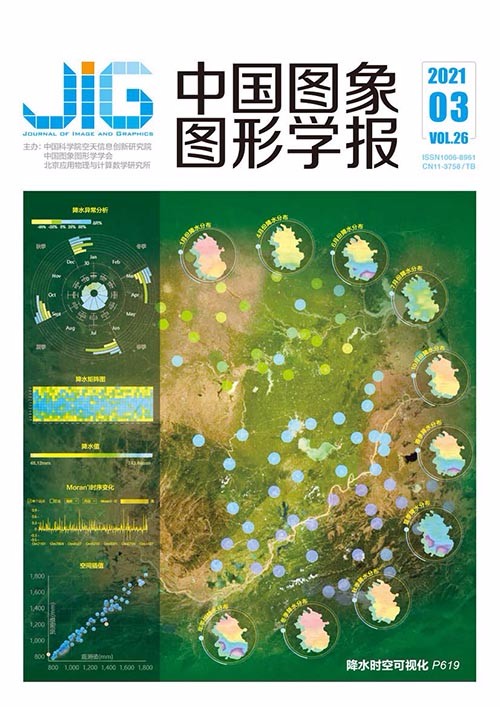
背景与方向感知的相关滤波跟踪
摘 要
目的 针对相关滤波跟踪算法,目标与周围背景进行等值权重训练滤波器导致目标与背景信息相似时,易出现目标漂移问题,本文提出一种基于背景与方向感知的相关滤波跟踪算法。方法 将目标周围的背景信息学习到滤波器中,利用卡尔曼滤波预测目标的运动状态和运动方向,提取目标运动方向上的背景信息,将目标运动方向上与非运动方向上的背景信息进行滤波器训练,保证分配给目标运动方向上背景信息的训练权重高于非运动方向上的权重,增加滤波器对目标和背景信息的分辨能力,采用线性插值法得到最大响应值,用于确定目标位置;构造辅助因子g,利用增广拉格朗日乘子法(augmented Lagrange method,ALM)将约束项放到优化函数里,采用交替求解算法(alternating direction method of multipliers,ADMM)将求解目标问题转化为求滤波器和辅助因子的最优解,降低计算复杂度;采用多分辨率搜索方法来估计目标变换的尺度。结果 在数据集OTB50(object tracking benchmark)和OTB100上的平均精确率和平均成功率分别为0.804和0.748,相比BACF (background-aware correlation filters)算法分别提高了7%和16%;在数据集LaSOT上本文算法精确率为0.329,相比BACF (0.239)的精确率得分,更能体现本文算法的鲁棒性。结论 与其他主流算法相比,本文算法在运动模糊、背景杂乱和形变等复杂条件下跟踪效果更加鲁棒。
关键词
Background and direction-aware correlation filter tracking
Jiang Wentao1, Tu Chao2, Liu Wanjun1(1.School of Software, Liaoning Technical University, Huludao 125105, China;2.Graduate School, Liaoning Technical University, Huludao 125105, China) Abstract
Objective Although the backgrocund-aware correlation filters (BACF) algorithm increases the number of samples and guarantees the sample quality, the algorithm performs equal weight training on the background information, resulting in the problem of target drift when the target is similar to the background information in complex scenes. The value weight training method ignores the priority of sample collection in the target movement direction and the importance of weight distribution. If the sample sampling method can be effectively designed in the target movement direction and the sample weights can be allocated reasonably, the tracking effect will be improved, and the target drift will be solved effectively. Therefore, this paper adds Kalman filtering to the BACF algorithm framework. Method For the single-target tracking problem, the algorithm in this paper only takes the motion vector from the predicted value and does not locate the target according to constant speed or acceleration. The target position is still determined by the response peak value. The maximum response value is obtained by linear interpolation. The target location is determined. When the speed is zero, the response peak of the target positioning in the previous frame image is still used to determine the target position in the current frame image. Kalman filtering is used to predict the target's motion state and direction, and the background information in the target's motion direction and non-motion direction is subjected to filter training to ensure that the training weight assigned to the background information in the target's motion direction is higher than the non-motion direction weights. The objective function problem is optimized and solved, auxiliary factor g is constructed, the augmented Lagrangian multiplier methodis usedto place the constraints in the optimization function, and the alternating solution method (alternating direction method of multipliers(ADMM) is used to optimize the filter and auxiliary factors,andreduce computational complexity. Result This paper selects standard data sets OTB50(abject tracking benchmark) and OTB100 to facilitate experimental comparison with the current mainstream algorithms. OTB50 is a commonly used tracking dataset, which contains 50 groups of video sequences and has 11 different attributes, such as lighting changes and occlusions. OTB100 containsan additional 50 test sequences based on OTB50. Each sequence may have different video attributes, making tracking challenges difficult. The algorithm in this paper uses one-pass evaluation (OPE) to analyze the performance of the algorithm, and tracking accuracy and success rate as the evaluation criteria. In video sequence Board_1, the algorithm in this paper, ECO(efficient convolution operators), SRDCF(spatially regularized correlation filters), and DeepSTRCF(deep spatial-temporal regularized) can achieve accurate tracking, but the speed of the algorithm in this paper is substantially better than that of the three two algorithms of ECO, SRDCF, and DeepSTRCF. In video sequence Panda_1, the tracking effect of the algorithm in this paper is stable under a low resolution. In video sequence Box_1, only the algorithm in this paper can accurately track the target from the initial frame to the last frame because the Kalman filter is used to predict the direction of the target and distinguish the target from the background information effectively. The tracker is prevented from tracking other similar background information. Experimental results show that the average accuracy rate and average success rate of the algorithm on datasets OTB50 and OTB100 are 0.804 and 0.748, respectively, which are 7% and 16% higher than the BACF algorithm, respectively. In tracking the experimental sequence, the tracking success rate and tracking accuracy of the algorithm in this paper are high and meet the real-time requirements, and the tracking performance is good. Conclusion This paper uses Kalman filtering to predict the direction and state of the target, assigns different weights to the background information in different directions, performs filter training, and obtains the maximum response value based on linear interpolation to determine the target position. The ADMM method is used to transform the problem of solving the target model into two subproblems with the optimal solution. The online adaptive method is used to solve the problem of target deformation in model update. Numerous comparative experiments are performed on OTB50 and OTB100 datasets. On OTB50, the algorithm success rate and accuracy rate of this paper are 0.720 and 0.777, respectively. On OTB100, the algorithm success rate and accuracy rate of this paper are 0.773 and 0.828, respectively.Both are better than the current mainstream algorithms, which shows that the algorithm in this paper has better accuracy and robustness. In background sensing, the sample sampling method and weight allocation directly affect target tracking performance. The next step is to conduct an in-depth research on the construction of a speed-adaptive sample collection model.
Keywords
computer vision target tracking correlation filter background-aware Kalman filters alternating direction method of multipliers(ADMM)
|



 中国图象图形学报 │ 京ICP备05080539号-4 │ 本系统由
中国图象图形学报 │ 京ICP备05080539号-4 │ 本系统由